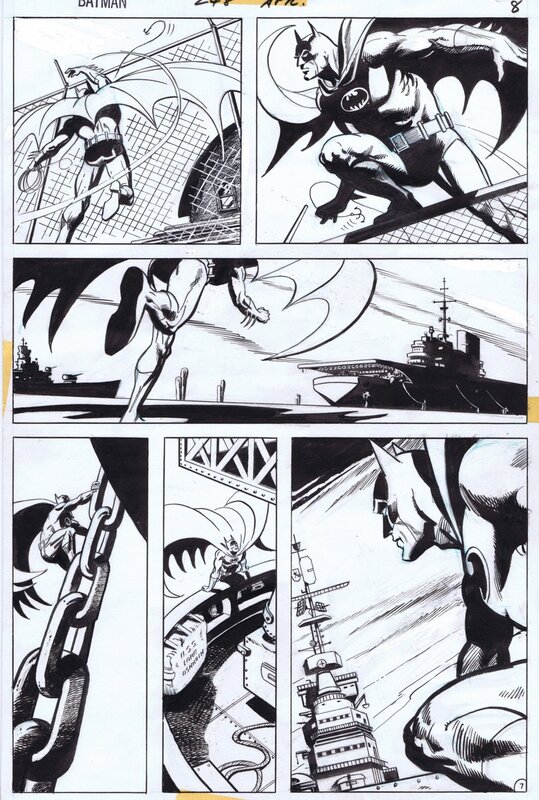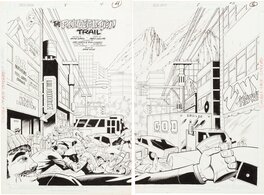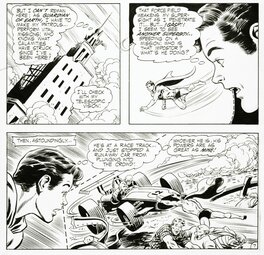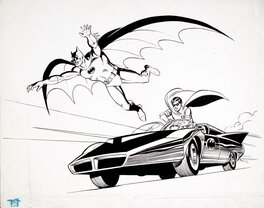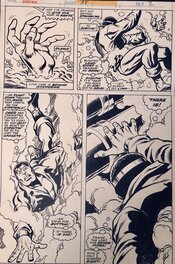Dans la collection de DietmarKrueger
Commentaire
"brown soon developed a tight, clean, and straight-forward interpretation of the Caped Crusader. It can be argued that he did not convey the back-to-its-roots air of mystery the Dark Knight (and his fans) so enjoyed in the early 1970s, but the artist was no slouch. Brown made you feel that Batman was a determined detective. My favorite Caped Crusader tale illustrated by Brown isn't even in Detective, but in a more 'obscure' location. What's so obscure about having your work published in an issue of Batman during that time? Simple. Neal Adams.
lt’s somewhat unfortunate that Adams’ undeniably dynamic work on Batman towers over his Bat-contemporaries. Fortunately, Irv Novick, ]im Aparo, and Frank Robbins (as artist) have garnered due recognition over the years. Not so with Brown, however, which is a shame, because his pencil work on 'Death-Knell For a Traitor' (Batman #248, Apr. 1973), written by Denny O'Neil and inked by Dick Giordano, is outstanding. Had it been illustrated by Adams, this account of an American traitor during World War ll, whose release from Gotham prison 30 years later attracts the interest of Batman and his nemesis Colonel Sulphur, would have been reprinted a hall-dozen times. l can't imagine Adams’ visual take on this tale, as Brown leaves such an indelible mark on it.
Not even the startling Michael W. Kaluta cover and Brown's dramatically paced 'silent' page 7 has generated much attention to this particular comic."
Jim Kingman - Back Issue #50 - Batman in the Bronze Age Issue p27
lt’s somewhat unfortunate that Adams’ undeniably dynamic work on Batman towers over his Bat-contemporaries. Fortunately, Irv Novick, ]im Aparo, and Frank Robbins (as artist) have garnered due recognition over the years. Not so with Brown, however, which is a shame, because his pencil work on 'Death-Knell For a Traitor' (Batman #248, Apr. 1973), written by Denny O'Neil and inked by Dick Giordano, is outstanding. Had it been illustrated by Adams, this account of an American traitor during World War ll, whose release from Gotham prison 30 years later attracts the interest of Batman and his nemesis Colonel Sulphur, would have been reprinted a hall-dozen times. l can't imagine Adams’ visual take on this tale, as Brown leaves such an indelible mark on it.
Not even the startling Michael W. Kaluta cover and Brown's dramatically paced 'silent' page 7 has generated much attention to this particular comic."
Jim Kingman - Back Issue #50 - Batman in the Bronze Age Issue p27
Thématiques
1 commentaire
Pour laisser un commentaire sur cette œuvre, veuillez vous connecter
A propos de Bob Brown
William Robert (Bob) Brown a étudié à l'École d'Art de Hartford dans le Connecticut et le Rhode Island School of Design. Il a réalisé sa première bande dessinée pour Timely («Young Hearts»), et des périodiques nationaux («La Vigilante») et Ziff-Davis («Famous Stars», «Cowboy Kid») et a travaillé à la fois pour les délais / Atlas national et / DC tout au long des années 1950, 1960 et 1970. Il a collaboré à "Star Spangled War Stories", "Challengers of the Unknown", "House of Mystery", "Tales of the Unexpected", "Tomahawks" (DC), "Mystery Tales", "Justice Comics" et "True Comics" (Atlas).
Brown était le créateur graphique du personnage "Space Ranger", paru dans la bande dessinée DC "Tales of the Unexpected" à partir de 1959.
Brown a illustré chaque histoire jusqu'à l'arrêt de la série en 1965. Il a également œuvré sue les séries DC "Superboy" et "Tom Sparks Boy Inventor".
Dans les années 1970, Bob Brown a dessiné des titres Marvel comme «Torpedo», «Daredevil», «Spider-Man», «Lilith», «Luke Cage Power Man» et «The Avengers».

